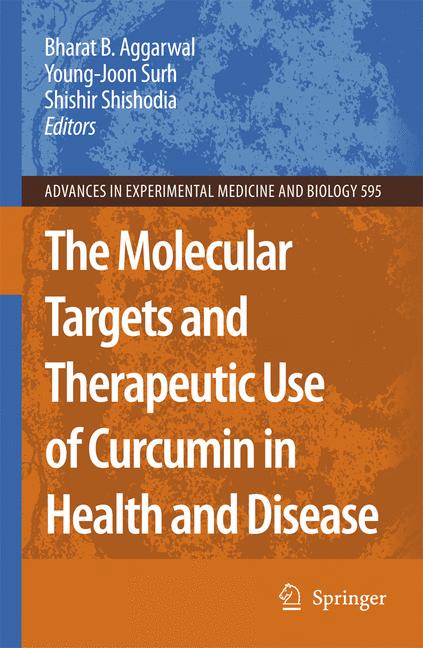| Chapter title |
Regulation of COX and LOX by curcumin.
|
|---|---|
| Chapter number | 9 |
| Book title |
The Molecular Targets and Therapeutic Uses of Curcumin in Health and Disease
|
| Published in |
Advances in experimental medicine and biology, June 2007
|
| DOI | 10.1007/978-0-387-46401-5_9 |
| Pubmed ID | |
| Book ISBNs |
978-0-387-46400-8, 978-0-387-46401-5
|
| Authors |
Rao CV, Chinthalapally V. Rao, Rao, Chinthalapally V. |
| Editors |
Bharat B. Aggarwal Ph.D., Young-Joon Surh Ph.D., Shishir Shishodia Ph.D. |
| Abstract |
Turmeric (Curcuma longa) is extensively used as a household remedy for various diseases. For the last few decades, work has been done to establish the biological activities and pharmacological actions of curcumin, the principle constituent of turmeric. Curcumin has proven to be beneficial in the prevention and treatment of a number of inflammatory diseases due to its anti-inflammatory activity. Arachidonic acid-derived lipid mediators that are intimately involved in inflammation are biosynthesized by pathways dependent on cyclooxygenase (COX) and lipoxygenase (LOX) enzymes. The role of LOX and COX isoforms, particularly COX-2, in the inflammation has been well established. At cellular and molecular levels, curcumin has been shown to regulate a number of signaling pathways, including the eicosanoid pathway involving COX and LOX. A number of studies have been conducted that support curcumin-mediated regulation of COX and LOX pathways, which is an important mechanism by which curcumin prevents a number of disease processes, including the cancer. The specific regulation of 5-LOX and COX-2 by curcumin is not fully established; however, existing evidence indicates that curcumin regulates LOX and COX-2 predominately at the transcriptional level and, to a certain extent, the posttranslational level. Thus, the curcumin-selective transcriptional regulatory action of COX-2, and dual COX/LOX inhibitory potential of this naturally occurring agent provides distinctive advantages over synthetic COX/LOX inhibitors, such as nonsteroidal anti-inflammatory drugs. In this review, we discuss evidence that supports the regulation of COX and LOX enzymes by curcumin as the key mechanism for its beneficial effects in preventing various inflammatory diseases. |
X Demographics
Geographical breakdown
| Country | Count | As % |
|---|---|---|
| United States | 3 | 38% |
| United Kingdom | 2 | 25% |
| Unknown | 3 | 38% |
Demographic breakdown
| Type | Count | As % |
|---|---|---|
| Members of the public | 5 | 63% |
| Practitioners (doctors, other healthcare professionals) | 2 | 25% |
| Scientists | 1 | 13% |
Mendeley readers
Geographical breakdown
| Country | Count | As % |
|---|---|---|
| United Kingdom | 1 | <1% |
| Cyprus | 1 | <1% |
| Brazil | 1 | <1% |
| Unknown | 148 | 98% |
Demographic breakdown
| Readers by professional status | Count | As % |
|---|---|---|
| Student > Bachelor | 27 | 18% |
| Student > Ph. D. Student | 20 | 13% |
| Researcher | 16 | 11% |
| Student > Master | 16 | 11% |
| Other | 11 | 7% |
| Other | 27 | 18% |
| Unknown | 34 | 23% |
| Readers by discipline | Count | As % |
|---|---|---|
| Agricultural and Biological Sciences | 31 | 21% |
| Medicine and Dentistry | 19 | 13% |
| Chemistry | 16 | 11% |
| Biochemistry, Genetics and Molecular Biology | 11 | 7% |
| Pharmacology, Toxicology and Pharmaceutical Science | 9 | 6% |
| Other | 25 | 17% |
| Unknown | 40 | 26% |
